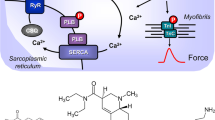Summary
Large coronary arteries of the dog were contracted with 5-hydroxytryptamine (5-HT). The 5-HT2-receptor antagonist ketanserin antagonized the 5-HT-induced effects. Unlike Brazenor and Angus (Europ J Pharmacol 81: 569–576, 1982), who reported insurmountable antagonism of the effects of 5-HT in dog coronaries, we found that the antagonism by ketanserin can be surmounted, provided the concentrations of 5-HT are high enough. Ketanserin also unmasked a saturable component of the 5-HT-induced contractions. Although ketanserin (0.1–1 μmol/l) depressed the maximal force of the saturable component, it did not change its EC50 (-log mol/l 8.0). We conclude that large coronary arteries of dog are contracted by 5-HT mainly though 5-HT2-receptors and to a smaller extent through receptors different from 5-HT2.
Similar content being viewed by others
References
Blinks JR (1965) Convenient apparatus, for recording contractions of isolated muscle. J Appl Physiol 20:755–757
Brazenor RM, Angus JA (1981) Ergometrine contracts isolated canine coronary arteries by a serotonergic mechanism: No role for alpha adrenoceptors. J Pharmacol Exp Ther 218:530–536
Brazenor RM, Angus JA (1982) Actions of serotonin antagonists on dog coronary artery. Eur J Pharmacol 81:569–576
Fozard JR (1982) Mechanism of the hypotensive effect of ketanserin. J Cardiovasc Pharmacol 4:829–838
Frenken M, Kaumann AJ (1984a) Interaction of ketanserin and its metabolite ketanserinol with 5-HT2-receptors in pulmonary and coronary arteries of calf. Naunyn-Schmiedeberg's Arch Pharmacol 326:334–339
Frenken M, Kaumann AJ (1984b) Interconversion between two 5-HT2-receptor states in large coronary artery (CA) of calf. Proceedings of the 9th International Congress of Pharmacology, London, UK, p 170 P
Kaumann AJ (1983) Yohimbine and rauwolscine inhibit 5-hydroxytryptamine-induced contraction of large coronary arteries of calf through blockade of 5-HT2-receptors. Naunyn-Schmiedeberg's Arch Pharmacol 323:149–154
Kaumann AJ, Frenken M (1984) A paradox: The 5-HT2-receptor antagonist ketanserin restores the 5-HT-induced contraction depressed by methysergide in large coronary arteries of calf Allosteric regulation of 5-HT2-receptors. Naunyn-Schmiedeberg's Arch Pharmacol 328:295–300
Leysen JE, Niemegeers CJE, Van Nueten JM, Laduron PM (1982) [3H] Ketanserin (R 41468), a selective 3H-ligand for serotonin2 receptor binding sites. Binding properties, brain distribution and functional role. Mol Pharmacol 21:301–314
Müller-Schweinitzer E, Engel G (1983) Evidence for mediation by 5-HT2 receptors of 5-hydroxytryptamine-induced contraction of canine basilar artery. Naunyn-Schmiedeberg's Arch Pharmacol 324:287–292
Author information
Authors and Affiliations
Rights and permissions
About this article
Cite this article
Frenken, M., Kaumann, A.J. Ketanserin causes surmountable antagonism of 5-hydroxytryptamine-induced contractions of large coronary arteries of dog. Naunyn-Schmiedeberg's Arch. Pharmacol. 328, 301–303 (1985). https://doi.org/10.1007/BF00515557
Received:
Accepted:
Issue Date:
DOI: https://doi.org/10.1007/BF00515557




